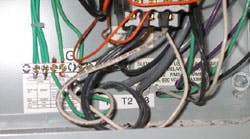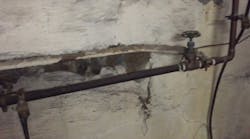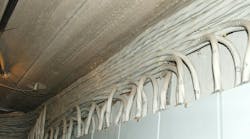As usual, never consider the following commentary associated with these photos as a formal interpretation of the National Electrical Code (NEC). Without criticizing anyone or any product, the following scenarios present us with serious safety questions.
TAKING POOR WORKMANSHIP TO A NEW LEVEL
Jeffrey Young, president, Young's Electrical Service, Chester, N.J., sent in these photos he took of a recently installed elevator control panel. One shows the flexible metal conduit and associated wiring in the wall cavity behind the control panel, and the other shows the wiring that enters the lower portion of the control panel.
The list of rules as to what's wrong can begin with 110.12. This isn't a neat and workmanlike installation.
The broken and loose flexible metal conduit indicates lost equipment-grounding conductors. The panel's interior speaks for itself.
WOULD YOU LIKE FRIES WITH THAT VIOLATION?
A reader in Scottsburg, Ind., found this interesting installation when he pulled into the drive-thru at a fast food restaurant. He noted that this wasn't a good way to demonstrate so many different wiring methods. “A little bit of EMT, a little Greenfield, a bit of IMC, and some SealTite thrown in just to keep it interesting,” he wrote. He assumed the ½-inch EMT (with the set screw connectors) was bent when the wire was pulled through it. He added, “And if it looks this bad on the outside, just imagine the actual wiring violations on the inside of those JBs.”
Intermediate metal conduit, flexible metal conduit, and liquidtight flexible metal conduit can't be installed where it will be subject to physical damage [90.4, 110.2, 110.3, 348.12(7), and 350.12(1)]. Electrical metallic tubing can't be installed where, during installation or afterward, it will be subject to “severe” physical damage [358.12(1)].
OUT WITH THE OLD, IN WITH THE NEW
Ed Peyton, owner, Ed's Electric, Albuquerque, N.M., got a call from a customer in the midst of a bathroom remodeling project who noticed discoloration of the fiberglass insulation backing around electrical wires and became concerned. Apparently, this wasn't the first time the house had undergone remodeling.
“At first, I couldn't make sense of the circuitry from the connections that were present so I started looking in cracks and such,” Peyton wrote. “When I stuck my head up through the hole where the exhaust fan had been removed I observed a mass of wires at the other end of the joist space. We removed the finished ceiling and found what is shown in the photograph. The ceiling joist was charcoal for about a ½ inch into the joist. Only providence kept the house from burning down. No box, no mechanical connections, no ground, and the installer didn't even maintain the polarity of the neutral and hot conductors. I convinced the customer to have me rip out all the old wiring and redo it correctly.”
A few rules for polarity in Art. 200, and for grounding and box requirements found in Art .250 and 300 would apply.
Found a Code violation? E-mail your photos to Joe Tedesco at [email protected].








